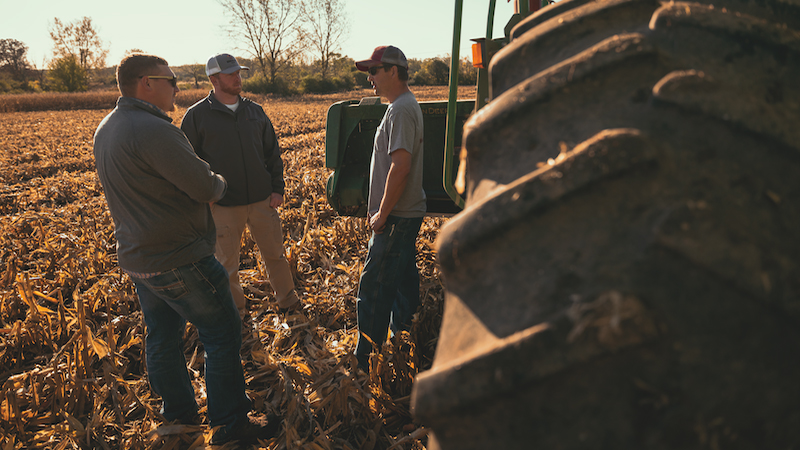Survey: An Inside Look At Precision Agriculture In 2013
Precision agriculture has established itself as a vital part of today’s farming systems. The specific roles precision agriculture plays in production agriculture, however, are ever changing — similar to the way sprinters might change positions during a track meet.
There are two major ways precision agriculture generates value — increasing returns (more acres per hour, higher yields, premium services for customers, etc.) or reducing costs (reduced overlap waste). The 16th CropLife®/Purdue University Precision Agriculture survey, sponsored by Trimble, shows that when it comes to the adoption of precision technology and the offering of precision services for dealerships, the more obvious the value or savings — either to the dealership itself or its customers — the faster and higher the adoption takes place.
Beyond technology-specific factors, the overall adoption of precision technologies, as a whole, seems to also relate to the health of the overall agricultural economy. The better the economy, the more cash growers and dealerships have to invest in technology. How confident are dealerships about the future of the agricultural economy? According to this year’s survey results, these groups are changing their investment behavior.
Technology At Dealerships
GPS guidance systems have been the anchor in the precision technology relay with either manual control (lightbar) or automatic control (automatic steering) being used by 82% of retailers responding (Figure 1). This year’s results for the usage of this equipment show little change from 2011 results. Lightbar usage was reported by 66% of respondents — the same as 2011 — and automatic steering was slightly lower at 62%, down from 63% in 2011. Forty-four percent of respondents indicated they used both lightbar and automatic steering technologies. In line with historic results, 18% did not report using either guidance technology (22% in 2011 and 22% in 2009).

The second group of precision technology asked about on the survey was agronomic diagnostic tools. By definition, these tools include satellite/aerial imagery, soil electrical conductivity mapping, chlorophyll/greenness sensors (CropSpec, GreenSeeker, OptRX, etc.) and other soil sensors for mapping (pH sensors, etc.). Of these, satellite/aerial imagery is the most widely used (40%) and highest jumper in use since 2011 (up from 31%). The use of chlorophyll/greenness sensors was reported at 7% on this year’s survey, up from 4% in 2011. Soil electrical conductivity mapping and other soil sensors for mapping saw little change since the last survey, used by 12% and 3% of respondents this year, respectively.
In the precision ag track meet, GPS-enabled sprayer booms with section or nozzle controls were the undisputed sprinters at the dealership level. New to the survey in 2011, the usage of this technology has jumped from 39% to a reported 53% in 2013 — the largest change of all the evaluated technologies. GPS-enabled sprayer boom adoption has been rapid. According to the survey, dealerships adopting GPS-enabled boom control immediately realized savings from reduced input overlap, creating immediate economic value. According to the respondents, this technology is only behind lightbars and automatic steering systems in terms of use among dealerships.
Also evaluated in the survey was a group of technologies used by dealerships for internal purposes. These technologies included fieldmapping with GIS to document work for billing/insurance/legal purposes, telemetry to send information to the home office from the field and GPS to manage vehicle logistics — tracking locations of vehicles and guiding them to the next site. Fieldmapping with GIS, used by 32% of respondents, is the most widely-used of this sub-group but has seen little change since 2011, where it was used by 30% of dealers. GPS for tracking vehicles increased from 16% in 2011 to 21% in 2013. Likewise, the use of telemetry technology also increased among dealerships, from less than 10% in 2011 to 15% this year.
Finally, about 15% of respondents indicated that they did not use precision ag technology — the same percentage as in 2011. Based upon this identical response level, conventional wisdom would indicate that there might always be a 15% block of retailers that does not use precision technology.
It’s hard to look at this list and not notice a vast difference in how these technologies are being adopted. Technologies such as GPS guidance are still the most prevalent and are holding their position at the top. Dealerships have also been able to quickly see the value of the GPS-enabled sprayer boom section and nozzle control technology, which are experiencing rapid growth behind GPS guidance systems. However, other technologies used by dealerships have seen a slow adoption curve or nearly no changes since 2011.
Services Offered
In addition to understanding the technologies that dealerships are using themselves, the survey also looked at the different precision agricultural services the dealerships offer their grower-customers. For a particular service, respondents were asked about their future plans in regards to those services. Figure 2 shows the percentage of respondents who offered the service in 2011, those that currently offer the precision service and the predicted level of offering by 2016. The predicted level was based on current offering rates and respondents that indicated they would add the service by 2016.

For variable-rate technology (VRT) used for application, single-nutrient fertilizer application is offered by more than 70% of respondents. Multiple-nutrient fertilizer and lime VRT applications are also prevalent, both currently being offered by more than 60% of respondents. All of the VRT used for application saw significant increases from the 2011 survey results, especially multiple-nutrients which increased from 42% to 65%. VRT application of pesticides is currently offered by only 29% of dealers, but 45% of the dealer responders indicate they will be offering variable-rate pesticide application by 2016.
The percentage of dealers offering satellite/aerial imagery also saw major growth since 2011. Currently being offered by 47% of respondents, only 25% of respondents offered the service two years before. Additionally, 66% of dealers predict that they will be offering this service by 2016.
The most widely offered service — soil sampling with GPS — is currently offered by more than 71% of respondents, compared to only 52% in 2011. If respondents’ plans hold true, 77% of dealers will offer this service by 2016.
The Question Of Profitability
Over the years, dealers have faced the challenge of pricing precision agricultural technologies and services at levels that will be attractive to customers while also generating profit for the dealers. As part of the survey, dealerships were asked how these various technologies affected their bottom lines. Figure 3 shows their ability to generate a profit or cover their variable and fixed expenses across different precision services.

Overall, the majority of VRT single- and multiple-nutrient fertilizer applicators were able to offer the service at a profit, 83% and 88% respectively. Soil sampling with GPS also had a large percentage of respondents (77%) indicate they were able to generate a profit. It should be noted that in most cases, these technologies are related and complementary. It is highly likely that a dealership would use results from the GPS soil sampling to use VRT nutrient application effectively.
Moving away from services that involve physically going across acres, the percentage of dealerships able to make a profit drops off. For satellite/aerial imagery, only 56% indicated they were making a profit.
The area of most profit difficulty appeared be the service and support functions. Only 39% of dealerships offering analysis for yield monitor data and 50% of those offering the sales/support functions for guidance or automatic steering systems were making a profit at these.
Seventy-five percent of respondents indicated that their overall precision product offerings were profitable. This is important as dealerships have to continually think of creative ways to recover their costs and generate a profit, either for each offered precision service or for the overall precision program.
Hurdles To Adoption
To understand some of the potential reasons why some precision agriculture technologies catch on while others struggle, the survey asked dealerships to respond to a list of potential barriers that may keep them from expanding their use of technologies. Their choices were either: strongly agree, agree, neutral, disagree or strongly disagree. These potential barriers could serve as a bottleneck keeping some technologies and services from being adopted.
Figure 4 shows how respondents agreed with the different questions. Overall, respondents indicated that the quick changes to the equipment needed to provide precision service was the biggest potential barrier, with 51% agreeing or strongly agreeing. Dealerships also expressed challenges in finding employees that can deliver the precision services (50% agreed or strongly agreed) and the fees that can be charged are not high enough to make precision services profitable (49% agreed or strongly agreed).

When asked if precision equipment is too complex, 39% of respondents disagreed or strongly disagreed that this was a barrier. Presented with a question about a lack of manufacturer support, 49% of respondents also disagreed, or strongly disagreed, that this was a barrier for technology adoption.
It’s important that these results are taken with consideration for respondents’ specific situations. While a majority may have agreed with a statement, there were still individual respondents who disagreed and vice versa.
Future Investments
For the adoption of precision technologies and services to expand, investments need to be made in precision equipment. A dealership’s decision to make an investment is dependent on the specific technology — how easily the benefits can be realized — and confidence in the overall agricultural economy. A strong agricultural economy makes cash available for such investments.
Figure 5 shows dealership plans for investments this year, 2013, and what they had planned to invest in 2011. For both years, the largest groups are those planning to invest less than $10,000 or making no investment. The most striking difference between the current and previous surveys is the jump in the percentage of respondents planning on making larger investments. In 2011, 19% of respondents planned to make investments in precision technology at a cost more than $50,000. This year, however, nearly 26% of respondents are planning to make significant precision investments.

Dealerships relying on guidance systems to more efficiently move their equipment through fields are now adding additional preciseness across their spray booms. Growers are using their agricultural retailers to obtain grid or zone soil nutrient information to guide their VRT fertilizer applications.
It is critical that every company and individual think about how precision agriculture is impacting its business. Does the precision technology pay? Twenty-five percent of respondents are not generating a profit from their precision program. Other key questions include are there ways to keep from replacing precision equipment so frequently and how do we find/recruit the employees who can work with these systems?
Since the last survey in 2011, a rising tide of overall agricultural prosperity has lifted dealership offerings of all precision services. However, looking at the previous survey and the number of respondents who don’t use precision technology, it suggests that this growth is mostly coming from dealerships expanding their precision offerings rather than new recruits.
From this year’s survey, it’s clear that technologies that dealerships can easily identify the value of — such as guidance systems and GPS-enabled sprayer boom control — have enjoyed the fastest adoption rates. There are also widespread offerings and more reported profitably with services that can be directly linked to crossing acres, such as GPS soil sampling and VRT application. Others, such as the diagnostic tools and technologies used by the dealership internally for management, have struggled with adoption rates by dealerships.
Thinking forward, the biggest challenge for any technology’s successful and fast adoption will be how obvious it is for dealerships and their grower-customers to realize the value. As the role of precision technology in production changes, there is no doubt that dealership offering these precision technologies and services will find creative ways to keep the industry relevant and growing.






